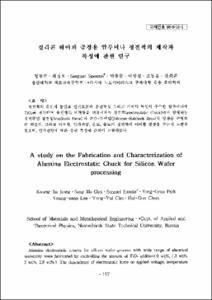화농성 관절염에 있어서 활액내 포도당 농도의 임상적 의의
- Alternative Title
- Clinical Significance of Glucose Concentration of the Synovial Fluid in Septic Arthritis
- Abstract
- Despite potent antimicrobial agents, septic arthritis continues to be one of the most damaging and prevalent forms of arthritis, resulting in serious sequelae. Synovial fluid analysis has been widely recommended as an important diagnostic tool for the diagnosis of the septic arthritis. But, there has been a debate about the clinical relevance of synovial fluid leukocyte count and glucose concentration in the diagnosis of septic arthritis. So, this study was performed to assess the clinical significances of synovial fluid analysis, especially glucose concentration of joint fluid in septic arthritis.
From August 1989 to March 1994, the data of the synovial fluid analyses were reviewed in fifty cases who were initially suspected of septic arthritis. We classified them into two groups, one with twenty culture-positive cases and the other with thirty culture-negative cases on synovial fluid bacterial culture. The results were as follows.
1. In culture-positive group, blood and synovial fluid leukocyte counts were not significantly increased, but the proportion of synovial fluid polymorphonuclear leukocytes was significantly increased(90% in average) as compared with culture-negative group.
2. The difference between serum and synovial fluid glucose concentrations showed a statistically significant increase in culture-positive group(54mg/dl in average of 15 cases) in contrast to culture-negative group(25mg/dl in average of 22 cases).
3. The ratio of synovial fluid glucose to that of the serum was significantly decreased in culture-positive group(44% in average of 15 cases) in contrast to culture-negative group (81% in average of 22 cases).
Despite potent antimicrobial agents, septic arthritis continues to be one of the most damaging and prevalent forms of arthritis, resulting in serious sequelae. Synovial fluid analysis has been widely recommended as an important diagnostic tool for the diagnosis of the septic arthritis. But, there has been a debate about the clinical relevance of synovial fluid leukocyte count and glucose concentration in the diagnosis of septic arthritis. So, this study was performed to assess the clinical significances of synovial fluid analysis, especially glucose concentration of joint fluid in septic arthritis.
From August 1989 to March 1994, the data of the synovial fluid analyses were reviewed in fifty cases who were initially suspected of septic arthritis. We classified them into two groups, one with twenty culture-positive cases and the other with thirty culture-negative cases on synovial fluid bacterial culture. The results were as follows.
1. In culture-positive group, blood and synovial fluid leukocyte counts were not significantly increased, but the proportion of synovial fluid polymorphonuclear leukocytes was significantly increased(90% in average) as compared with culture-negative group.
2. The difference between serum and synovial fluid glucose concentrations showed a statistically significant increase in culture-positive group(54mg/dl in average of 15 cases) in contrast to culture-negative group(25mg/dl in average of 22 cases).
3. The ratio of synovial fluid glucose to that of the serum was significantly decreased in culture-positive group(44% in average of 15 cases) in contrast to culture-negative group (81% in average of 22 cases).
- Issued Date
- 1994
- Type
- Research Laboratory
- Alternative Author(s)
- Ahn,Hyung Sun; Lee,Choon Sung
- Publisher
- 울산의대학술지
- Language
- kor
- Rights
- 울산대학교 저작물은 저작권에 의해 보호받습니다.
- Citation Volume
- 3
- Citation Number
- 2
- Citation Start Page
- 46
- Citation End Page
- 51
- Appears in Collections:
- Research Laboratory > The ULSAN university medical journal
- 파일 목록
-
-
Download
 000002024397.pdf
기타 데이터 / 525.38 kB / Adobe PDF
000002024397.pdf
기타 데이터 / 525.38 kB / Adobe PDF
-
Items in Repository are protected by copyright, with all rights reserved, unless otherwise indicated.